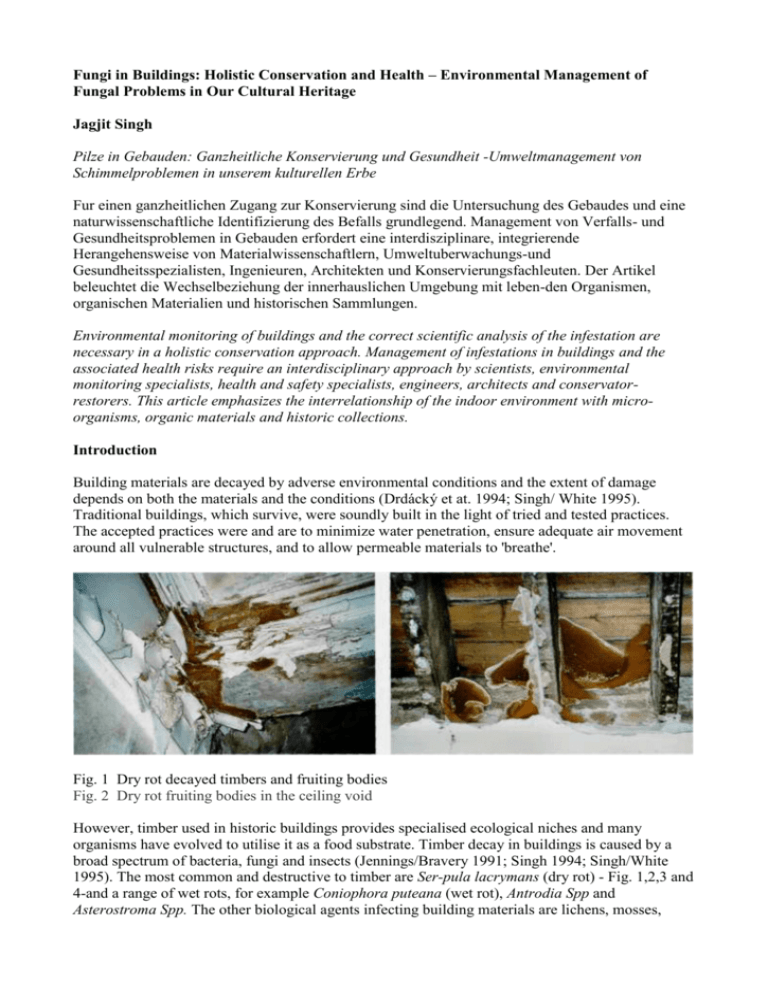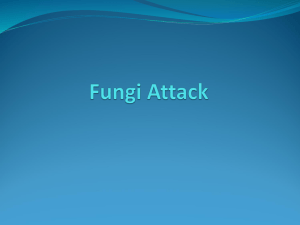Fungi in Buildings: Holistic Conservation and Health
advertisement

Fungi in Buildings: Holistic Conservation and Health – Environmental Management of Fungal Problems in Our Cultural Heritage Jagjit Singh Pilze in Gebauden: Ganzheitliche Konservierung und Gesundheit -Umweltmanagement von Schimmelproblemen in unserem kulturellen Erbe Fur einen ganzheitlichen Zugang zur Konservierung sind die Untersuchung des Gebaudes und eine naturwissenschaftliche Identifizierung des Befalls grundlegend. Management von Verfalls- und Gesundheitsproblemen in Gebauden erfordert eine interdisziplinare, integrierende Herangehensweise von Materialwissenschaftlern, Umweltuberwachungs-und Gesundheitsspezialisten, Ingenieuren, Architekten und Konservierungsfachleuten. Der Artikel beleuchtet die Wechselbeziehung der innerhauslichen Umgebung mit leben-den Organismen, organischen Materialien und historischen Sammlungen. Environmental monitoring of buildings and the correct scientific analysis of the infestation are necessary in a holistic conservation approach. Management of infestations in buildings and the associated health risks require an interdisciplinary approach by scientists, environmental monitoring specialists, health and safety specialists, engineers, architects and conservatorrestorers. This article emphasizes the interrelationship of the indoor environment with microorganisms, organic materials and historic collections. Introduction Building materials are decayed by adverse environmental conditions and the extent of damage depends on both the materials and the conditions (Drdácký et at. 1994; Singh/ White 1995). Traditional buildings, which survive, were soundly built in the light of tried and tested practices. The accepted practices were and are to minimize water penetration, ensure adequate air movement around all vulnerable structures, and to allow permeable materials to 'breathe'. Fig. 1 Dry rot decayed timbers and fruiting bodies Fig. 2 Dry rot fruiting bodies in the ceiling void However, timber used in historic buildings provides specialised ecological niches and many organisms have evolved to utilise it as a food substrate. Timber decay in buildings is caused by a broad spectrum of bacteria, fungi and insects (Jennings/Bravery 1991; Singh 1994; Singh/White 1995). The most common and destructive to timber are Ser-pula lacrymans (dry rot) - Fig. 1,2,3 and 4-and a range of wet rots, for example Coniophora puteana (wet rot), Antrodia Spp and Asterostroma Spp. The other biological agents infecting building materials are lichens, mosses, algae, moulds, bacteria and a range of insects and fungi (Bech-Andersen 1991; Cartwright/Findlay 1958; Richardson 1986; Singh 1993; Verral & Amburgey 1977). Remedial Chemical treatment Approach The lack of repair, organisational culture and poor maintenance and management leads to radical solutions to building decay. The attraction of remedial treatments was irresistible and it was hoped that deficiencies in the quality of materials, workmanship or maintenance could be compensated for by the ubiquitous application of cheap, general-purpose pesticide mixtures. The problems associated with the approach have often become clear. Remedial treatment of the infestations with fungicidal chemicals is not only expensive, inconvenient, hazardous to the operatives and occupants, but is also now becoming environmentally unacceptable. Orthodox measures could entail the loss of irreplaceable decorative finishes, floors and ceilings. Eradication of, for example, dry rot spores or insect pests in an historic building and its contents is, in practice, impossible. The volumes of chemicals necessary and the toxicity required would be damaging both for the building and all its occupants. Environmental Holistic Approach Environmental control and preventative maintenance are preferred to draconian chemical treatments, as they provide a long-term solution to the health of the building and its occupants. A correct scientific analysis can provide an alternative, less destructive solution. Controlling the environment around a susceptible biodegradable material is still the most frequently used method of preventing biological decay. Correct identification of the fungal and insect material is important, as not all fungi are equally destructive. Some rots are present in timber when it is cut or are acquired during storage. Fungal material may also be dead or dormant, representing conditions now past (Singh/White 1995). Causes of Decay The decay of building materials is caused by a number of factors, which are outlined below (Allsopp/Seal 1986; Bravery et al. 1987): - Fungal decay - Insect decay - Chemical decay - Mechanical wear - Decomposition by physical agencies, for example: prolonged heating, fire and moisture Recent advances in the understanding of the pathology of dry rot Recent advances in the understanding of the pathology of dry rot has been described by Singh et al. 1993; Singh/White 1995 (a); White et al. 1995; Singh/White 1995; Palfreyman et al. 1995. Whilst the dry rot fungus Serpula lacrymans resides frequently in buildings in Northern and Central Europe, Australia, Japan and other temperate regions, it has very rarely been Fig. 3 Dry rot fruiting bo-dies mycelium and strand Fig. 4 Author checking moisture content of timber decayed with dry rot reported to be growing in the wild, notably in specific areas of the Himalayan foothills (Fig. 5), forests of the Czech Republic and Californian mountains. Diagnosis of decay The following techniques are used to diagnose the decay: - Physiochemical and morphological characteristics of decay - Cultural characteristics of decay - Molecular analysis - Non-destructive Inspection techniques (Singh 1991) (Fig. 6) Preliminary inspection and investigations The basis of any investigation is an understanding of building structures and defects and how these may interact to produce the ecological niches in which various decay organisms can thrive. With experience, an initial visual inspection can give a good indication of areas that will need closer study. A checklist for this preliminary investigation includes building defects, significant timber structures and concealed cavities. Obviously it is important to be familiar with the ecology and signs of significant decay organisms. Specialist search techniques The condition of concealed timbers and cavities may be deduced from the general condition and moisture content of the adjacent structure. Only demolition or exposure work can enable the condition of timber to be determined with certainty and this destroys what it is intended to preserve. A non-destructive approach is therefore required and, to help reduce uncertainty, instrumentation and test equipment can be useful at this stage. However, it is important to remember that all tests and instruments are only aids to the surveyor, and must be interpreted with experience and care. A slavish reliance on any technique, and failure to take into account its limitations, is a recipe for disaster. The nondestructive inspection includes the use of moisture meters, fibre optic inspection, Resi-stograph, ultrasonic, and infrared techniques. Detailed investigation The findings from the initial investigations are followed up by more detailed study. The aim is to determine the distribution and extent of all significant decay organisms in the building, the distribution of all microenvironments predisposing to timber decay and the building defects that cause them. The distribution of moisture and its movement through the structure is particularly important. The extent of significant timber decay should also be determined. Active decay organisms may not yet have caused significant timber decay. Conversely, there may be significant decay even when the decay organisms that caused it have been dead for many years. This may seem obvious, but many expensive 'treatments' are carried out on fungus-damaged timber that has not been infected for tens or even hundreds of years. Key factors to be noted are species and viability of decay organisms, moisture content of materials, ambient relative humidity and ventilation. Timber species and previous chemical treatments may also be significant. Other techniques used include microscopy, laboratory culture and identification of fungi and insects, hot wire anemometer and electronic RH measurement. More exotic techniques may sometimes be useful such as pheromone insect traps, infrared ther-mography, short wave radar, automatic weather stations, ultrasonic detection of timber boring insects, and total building monitoring using specialist data loggers. It is important to remember that any technique must be carefully justified because the value of the information from techniques not routinely used or properly calibrated can be very limited. Fig. 5 Wild dry rot in Himalaya discovered by author. Fig. 6 Endoscopic inspection of floor void Ecological Factors affecting Timber Decay The environmental factors favouring the decay of timber are temperature, water, humidity and lack of ventilation (Oxley/Govert 1995; Singh 1991). Moisture in buildings The following factors contribute to moisture in buildings: - Penetrating damp/rising damp - Condensation - Building disaster (fire and flood) - Construction moisture - Building defects Fungi differ in their optimum temperature requirements, but for most the range is from about 20-30 °C. The optimum temperature for dry rot growth in buildings is about 23 °C, maximum temperatures are about 25°C and the fungus is rapidly killed above 40°C. Timber moisture contents in buildings in the 20-30% range are ideal for dry rot attack and other infestations. Environmental Monitoring Remote monitoring systems can be very useful in increasing the efficiency and decreasing the cost of maintenance programmes. They can be especially useful for checking the moisture content of inaccessible timbers in roof spaces, behind decorative finishes and in walls. The Greener Approach Environmental control relies on controlling the cause of the problem by controlling the environment. - Locate and eliminate sources of moisture - Promote rapid drying - Determine the full extent of the outbreak - Remove the rotten wood - Determine the structural strength of timber and fabric construction - Institute good building practice: - ventilation - Damp Proof Course (DPC) - isolation The environmental control is complex and requires a multi-disciplinary team of scientists, engineers, surveyors and computing skills (Singh/White 1995). Building Health Building affects the health of occupants in many ways, for example building related illnesses (BRI), Sick Building Syndrome (SBS) and allergy and environmental health problems (AEHP). The most common building health problems in buildings relates to dampness and condensation resulting in mould growth, house dust mite and a range of other fungal & insect pests, aggravating respiratory problems and allergies (Singh 1999 [a], Singh 1999 [b], Singh .2000). Building Mycology Building Mycology is defined as that branch of mycology, which deals with the study of fungi, associated with buildings, contents and their environments, which has a direct or indirect effect on the performance of building materials and structures and the health of the contents and occupants. Previous studies have drawn attention to the fact that lessons learned from studies of agricultural exposures to fungal spores and from mycotoxicology can be applied to the understanding of the consequences of inhalation of fungal particles in domestic and non-industrial indoor environments. A number of recent review papers have dealt with the problem of fungi in indoor air and attempted to focus attention on various issues, particularly air sampling and the biomedical consequences of inhalation exposure to fungal propagules (Flannigan 1992; Miller 1992). Allergy & Damp-building syndrome Buildings, which suffer from dampness (rising or penetrating dampness), moisture problems due to condensation, fire and flood damage can significantly higher the number of microorganisms in the indoor environment. This creates problems for allergic patients. A prolonged residual moisture problem may also cause troubles for nonallergic people, who may also develop several of the mucosal and general symptoms (Morris 1990; Gra-vesen et. al 1994; CIAR 1996). Indoor Allergens There are more than 100 000 species of fungi. The genera and species that cause human disease involve a wide array of fungi. The most common fungi in both adult and pediatric populations in descending order of frequency were Alternaria, Helminthosporium, Cla-dosporium, Fusarium, Aspergillus, Phoma and Penicillium (CIAR 1996). Other moulds of allergenic importance include, for example Botrytis, Rhizopus and Trichoderma. A clinically important yeast allergen is Candida, which forms pseudo-hyphae. Fungi produce large numbers of spores and when these spores liberated from infected buildings to the indoor air, it can be regarded as organic dust. These spores can, like other types of dust, sediment on surfaces or it could be inhaled by occupants and deposited on the mucosal surface of the upper airways and in the eyes. Repeated exposure to large amount of fungal propagule risks the development of specific allergic reactions. Strategies for Control, Sustainable Holistic Solutions Building structures and environments provide specialised microclimates and ecological niches in their spatial ecosystems for the settlement, growth and proliferation of a variety of fungal organisms. Fungal and insect problems in both modern and historic buildings are mainly the result of defects in buildings, lack of maintenance and gross neglect. Rectifying these defects and by ensuring proper maintenance can provide long term sustainable, holistic solutions to these problems (Singh 1993; Singh 1994 [a]; Singh/Walker 1994 [b], Singh 1994 [c]; Singh 1996 [a]; Singh 1996 [b]). Management of decay and health problems in buildings is a complex issue; it requires a multidisciplinary integrated approach, which combines the skills of material scientists, environment monitoring and health specialists, conservation science engineers and architects. Environmental Management Much damage has been inflicted in the last century by dealing with the symptoms of the problems and not with the causes. By proper understanding of the causes, its repetition should be avoided in this century. The environmental approach is beneficial to the building fabric, occupants and to the wider environment. References D.AIIsopp/K.J. Seal, Introduction to Biodete-rioration. Edward Arnold, London 1986, p. 135. A. F. Bravery/R. W. Berry/J. K. Carey/D. E. Cooper, Recognising Wood Rot and Insect Damage in Buildings. BRE Garston, Watford, UK 1987. J.Bech-Andersen, The Dry Rot Fungus and Other Fungi in Houses. Hussvamp Labora-torietaps, Denmark, 1991-92, pp. 19. K. S. G. Cartwright/W. P. K. Findlay, Decay of Timber and its Prevention. HMSO, London 1958. CIAR Sick Building Syndrome, Biological Aerosols and System Control of Indoor Air Quality. CIAR, Maryland 1996. M. Drda'cky/J. Palfreyman/J. Singh, Conservation & Preservation of Timber in Buildings. ISBN 80-901118-4-X. Prague, Czech Republic 1994. B. Flanningan, Indoor microbiological pollutants - sources, species, characterisation an evaluation, in: H. Knoppel/P. Wolkoff (ed.), Chemical, microbiological, health and comfort aspects of indoor air quality - State of the art in SBS. Kluwer, Dordrecht 1992, pp. 73-98. S.Gravesen/J.C. Frisvad/R.A. Samson, Microfungi. Munksaard, Holland 1994. Morris Greenberg, Allergy in Buildings and Health, in: S.Curwell/C. March/R.Venea-bles (ed.), The Rosehaugh Guide. London 1990 (RIBA). D. H. Jennings/A. F. Bravery (Ed.), Serpula Lacrymans: Fundamental Biology and Control Strategies. John Wiley & Sons Inc., Chichester, UK 1991. J.D. Miller, Fungi as contaminants in indoor air. Atmospheric environment, 26. 1992, pp.21632172. T. A. Oxley/E. G. Govert, Dampness in Buildings: Diagnosis, Treatment, Instruments, London, UK 1995 (Butterworths, 2nd Edition). J.Palfreyman/N.White/T. E. J.Buithjens/ H. Glancy, The impact of current research on the treatment of infestations by the dry rot fungus Serpula lacrymans, in: International Biodeterioration & Biodegradation 35, pp. 369-395. B. A. Richardson, Remedial Treatment of Buildings. The Construction Press, Lancaster, UK 1986, pp.236. J.Singh, Building biology and health, in: S.Johnson (ed.), Greener Buildings, Environmental Impact of Property. Macmillan Press, London 1993, pp. 122-44. J. Singh, Building Mycology: Management of decay and health in buildings. E & FN Spon, London, UK 1994. J.Singh/J.Bech-Andersen/A.S. Elbourne/ S.Singh/B.Walker/T.Goldie, The Search for Wild Dry Rot Fungus (Serpula Lcrym-ans) in the Himalayas. The Mycologist, 7(3), 1993, pp. 124-131. J.Singh, Non-destructive inspection of the building fabric, in: T. Banns (ed.), Proceedings of Building Pathology 90. UK, 1991, p. 215. J. Singh, Biological contaminants in the built environment and their health implications. Building Res. Inform, Vol. 21, No 4. 1993, pp. 216-224. J. Singh, Building Mycology Management of Health and Decay in buildings. London 1994. (a) J.Singh/B.Walker, Allergy Problem in Buildings. Quay Publishing, Lancaster 1994. (b) J. Singh, Indoor Air Quality in Buildings. Office Health & Safety Briefing, Croner 1994. (c) J. Singh, Health, comfort and productivity in the indoor environment. Indoor and Built Environment, 51, Jan-Feb 1996. Karger Publications, 1996, pp. 22-34. J. Singh, Impact of indoor air pollution on health, comfort and productivity of the occupants, in: Aerobiologia 12, 1996, pp. 121-127. J. Singh, Sick Building Syndrome. Facilities Management, in: Health and Safety, November 1999, pp. 12-15. J. Singh, Sick Building Syndrome, Occupational Health and Hygiene, in: Health and Safety, December 1999, pp. 14-16. J. Singh, Allergic Reactions, Occupational Health and Hygiene, in: Health and Safety, February 2000, pp. 14-16. J.Singh/N. White, The Search for Himalayan link to a dry rot cure in buildings, in: Building Research & Information, Vol 23, No 4. 1995, pp. 216-20. (a) J. Singh/N. White, Dry rot and building decay: a greener approach, in: Construction Repair, 1995, pp. 25-32. (b) J.Singh/S.Singh/B.Walker/J.Palfreyman/ N. White, Searching for answers at the roof of the world. Dry rot special report in Buildings & Facilities Management for the Public Sector, 1995, pp14-16. J. Singh/N. White, Himalayan origin of dry rot. Comparative ecology in domestic and wild environment, in: J. Singh/N. White (ed.), Environmental Preservation of Timber in Buildings. Published by Oscar Faber. StAlbans, UK 1995. J. Singh/N. White, Timber decay in buildings -Research, Remedies & Reform, in: L.Reinprecht/D.Cebecauerova (ed.), Reconstruction & Conservation of Historic Wood. Bratislava, Slovak Republic 1995. J.Singh/N. White. Environmental Preservation of Timber in Buildings. ISBN 1 900 390 00 0. StAlbans, UK 1995. F. A. Verral/L. T. Amburgey, Prevention and Control of Decay in Homes. US Government Printing Office, Washington DC 1977, p. 148.








